Stroke of Genius
by Patty Gelb
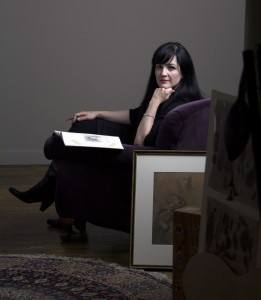 Suffering a stroke is a life-altering event for any person, but for Leslie Adams, the talented portrait artist who has painted such notable public figures as Governor Bob Taft, Senate President Bill Harris, Chief Justice Thomas Moyer and others, suffering a mini-stroke created inspiration.
Suffering a stroke is a life-altering event for any person, but for Leslie Adams, the talented portrait artist who has painted such notable public figures as Governor Bob Taft, Senate President Bill Harris, Chief Justice Thomas Moyer and others, suffering a mini-stroke created inspiration.
There are various ways you could be familiar with Leslie Adams, the University of Toledo’s “Outstanding Alumna in the College of Arts and Sciences” in 2003, and her work. As an artist living in the state of Ohio, she has been commissioned to paint the official portraits of almost a dozen important gubernatorial, judicial and legislative leaders. Her portrait of the Most Reverend Bishop James Hoffman is part of the collection of the Catholic Diocese of Toledo. As a UT alumna, you might have seen her portrait of former University of Toledo President Daniel Johnson. But her mini-stroke in 2009 made Leslie reflect on her life and create an inspired self-portrait which changed her course. That course change turned into her recent Toledo Museum of Art solo exhibition “Leslie Adams, Drawn from Life” that ran from mid-October, 2012 through February, 2013 during the museum’s acclaimed Fall Season of Portraiture.
A Toledo native, Leslie received her Bachelor of Fine Arts Degree in Drawing and Printmaking from UT in 1989. She attributes her first introduction to the academic study of human anatomy and figurative art to her mentor and friend, UT Professor Diana Attie. In 1990, she was awarded the Grand Prize in the first “International Drawing Competition” sponsored by the Warhol Foundation for the Visual Arts. That prize included the coveted Warhol Scholarship which enabled her to attend the New York Academy of Art, where in 1992 she received her Master of Fine Arts Degree in Figurative Art.
After receiving her master’s degree, Leslie returned home to Toledo. Her family and fond memories of her childhood were here including her memories of experiences at the Toledo Museum of Art. Leslie explained, “As a child, the Toledo Museum of Art (TMA) was my playground. Within its walls, I was given the opportunity of being surrounded by great art as well as the extraordinary privilege of beginning my formal art education. It was this introduction that prepared me for my advanced study in the fine arts.” But now back in Toledo, she found herself trying to figure out what she wanted to do with her life. She began her career painting murals for friends who owned businesses that included a gym, a Harley Davidson shop at a mall and a restaurant. This led to a major commission from St. John’s Jesuit High School. The commission inspired and challenged Leslie because, not only was it a large-scale realistic mural, it was based on the 450-year history of the Jesuits and therefore, it was overflowing with historical content and meaning.
Leslie continued to receive commissions to paint murals, but more and more requests came for portraits, as well. Painting large-scale murals is time-consuming, is physically demanding, and often requires working on location. She prefers working in the privacy of her own studio. Toward the end of the 90’s she made the decision to focus on portraits exclusively.
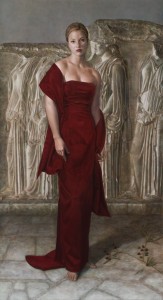 And focus on portraits she did. Completed in 2001, “Athena” is Leslie’s first full-length portrait. It presents the Greek goddess as a strong, contemporary figure. With an olive branch at her feet, unadorned and barefoot, she represents the goddess of wisdom and art in her own age. This has become Leslie’s signature portrait.
And focus on portraits she did. Completed in 2001, “Athena” is Leslie’s first full-length portrait. It presents the Greek goddess as a strong, contemporary figure. With an olive branch at her feet, unadorned and barefoot, she represents the goddess of wisdom and art in her own age. This has become Leslie’s signature portrait.
Leslie later completed the “Portrait of the Most Reverend Bishop James R. Hoffman” in 2005. This posthumous portrait was dedicated at a memorial Mass on the second anniversary of his death and adorns the Bishop’s Chapel of Our Lady of the Most Holy Rosary Cathedral in Toledo, Ohio. During the unveiling ceremony, Bishop Leonard Blair, successor to Bishop Hoffman, stated, “This truly beautiful portrait is worthy of this magnificent cathedral, it is worthy of this historic diocese and it is worthy of Bishop James Hoffman.” The work, painted in the classical realist style of the artist in keeping with the manner of the previous five bishops’ portraits, took over a year to research, plan and execute.
 That same year, the Ohio Arts Counsel held a call for artists for the official gubernatorial portrait for the Ohio Statehouse. Although it was a national call, they acknowledged their preference for an Ohio artist and Leslie applied. After several rounds of interviews and a final meeting with Governor and Mrs. Taft, she was offered the commission. “I think it is always important for the artist and the subject to meet before commissioning a portrait. We must have a very good relationship and a good rapport because we are spending hours and hours together during the process. It is a uniquely shared experience to have a portrait done and I have found that I have become personal friends with so many of my subjects and their families.” said Leslie.
That same year, the Ohio Arts Counsel held a call for artists for the official gubernatorial portrait for the Ohio Statehouse. Although it was a national call, they acknowledged their preference for an Ohio artist and Leslie applied. After several rounds of interviews and a final meeting with Governor and Mrs. Taft, she was offered the commission. “I think it is always important for the artist and the subject to meet before commissioning a portrait. We must have a very good relationship and a good rapport because we are spending hours and hours together during the process. It is a uniquely shared experience to have a portrait done and I have found that I have become personal friends with so many of my subjects and their families.” said Leslie.
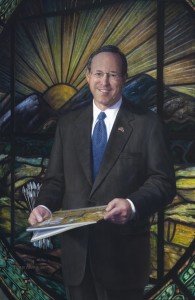 Governor Taft’s portrait, unveiled in 2007, includes symbolic imagery often found in Leslie’s portraits. In the work, the Governor is seen holding a book he published called “Along the Way” that contains photographs of his favorite places in Ohio. The book is open to a photograph of his daughter, Anna. Mr. John Bobb, fine arts consultant for the Statehouse stated, “Adams’ painting is the best portrait to be hung in the [Ohio] Statehouse since the late nineteenth century.” The painting now hangs in the William Howard Taft Hearing Room directly across from a portrait of the governor’s great-grandfather.
Governor Taft’s portrait, unveiled in 2007, includes symbolic imagery often found in Leslie’s portraits. In the work, the Governor is seen holding a book he published called “Along the Way” that contains photographs of his favorite places in Ohio. The book is open to a photograph of his daughter, Anna. Mr. John Bobb, fine arts consultant for the Statehouse stated, “Adams’ painting is the best portrait to be hung in the [Ohio] Statehouse since the late nineteenth century.” The painting now hangs in the William Howard Taft Hearing Room directly across from a portrait of the governor’s great-grandfather.
This major portrait commission led to later commissions from the Ohio Statehouse, Ohio Senate and House of Representatives, and the Supreme Court of Ohio including portraits of Governor Ted Strickland, Chief Justice Thomas J. Moyer, Senate President Bill Harris, Judge Robert M. Duncan and other prominent political and judicial leaders.
Leslie describes the dedication of a portrait as an “unveiling of the collaboration between the subject and the artist.” She adds that this is the most terrifying part of the process because of the prestige and often the sheer scale of the event. For the unveiling of Governor Strickland’s portrait there were over 650 prominent people in attendance. Leslie spoke before Governor Strickland and immediately after our American astronaut and hero, Senator John Glenn. “Not much pressure there, right?” Leslie said with a laugh. Leslie explained that beyond the process of painting the portrait, she needed to grow accustomed to public speaking, which has not always been easy for her. She is often asked, however, to speak about the process of painting a portrait and working with each individual subject from the artist’s point of view.
“Every single one of the portraits that I have done has been completely different. I do love talking about those differences to the audience. For example, occasionally I will work with an unwilling subject because there are a lot of humble people who simply say ‘I don’t need a portrait, that’s just silly, or just hang a photograph, I remind them that ‘this is tradition, this is the history of our state, this is the history of the Ohio Statehouse, and this is the history of the office of the Governor, Chief Justice, Senator or Speaker.’ And I love being a part of our state’s history.”
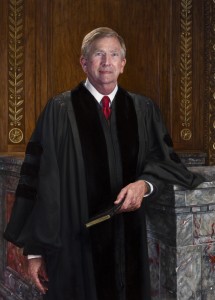 Leslie described an inspirational moment while working on the posthumous portrait of Ohio Supreme Court Chief Justice Thomas J. Moyer. He had written, before his death, “Great judges share with the great artists a vision for the big picture, the entirety of society; the artist and the judge share a concern for life in its many forms, its successes and its failures.” Leslie was very inspired by this profound statement, and her portrait of Chief Justice Moyer attempts to portray Tom Moyer’s role in the history of our state and our nation…as a judge and as a man.
Leslie described an inspirational moment while working on the posthumous portrait of Ohio Supreme Court Chief Justice Thomas J. Moyer. He had written, before his death, “Great judges share with the great artists a vision for the big picture, the entirety of society; the artist and the judge share a concern for life in its many forms, its successes and its failures.” Leslie was very inspired by this profound statement, and her portrait of Chief Justice Moyer attempts to portray Tom Moyer’s role in the history of our state and our nation…as a judge and as a man.
“It has been said that the role of a portrait artist is much like that of a biographer. Their work tells the story of an individual by creating a lasting record and a testament to their important role in history.” according to Leslie. She adds, “The Supreme Court of Ohio rededicated their building in December, 2011 and it is now called the Chief Justice Thomas J. Moyer, Ohio Judicial Center. It amazes me that the first thing you see when you walk in is my painting and, moreover, that will be displayed there forever! This is my contribution. I am just a painter, but painting is my contribution to our state’s history.”
According to Leslie, a portrait is more than capturing a likeness. It is about finding the essential character of the individual, more so than just taking a snapshot and capturing what the person looked like at a particular time. Leslie prefers to paint from life when she can because she learns something more about the person at each sitting. “You can capture an attitude from one sitting, the color of the flesh in another sitting, the curl of the eyebrow, the person’s grin. Portraits should tell stories,” she said.
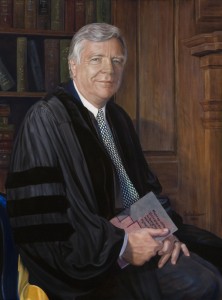 That is why you will see the recurrent use of imagery and objects that help tell the story of a person’s life in her portraits. Even if it is just a simple portrait of a man standing with his hand at his chin with a solid background, the story might be about the watch that he is wearing, a college ring, a book that he is holding. In Dr. Daniel M. Johnson’s portrait for The University of Toledo, President Johnson is holding his book, “Metropolitan Universities: An Emerging Model in American Higher Education,” published in 1995. In the portrait of Chief Justice Thomas J. Moyer, he is holding a copy of the constitution, bookmarked to Article III which established the Judicial Branch of the Federal Government. There are many secrets and symbols throughout Leslie’s works. It might be the senator’s gavel resting on the marble that was made from an ash tree because that Senator was from Ashland County in Ohio. It also may be something that is less obvious or more obscure. In Governor Strickland’s portrait, there is a bust of Lincoln in the background with papers laid out on his desk that were important bills during his term of office. He is portrayed in the Governor’s office in the Statehouse, usually only used for ceremonial occasions. He was the first leader of our state to use this location in many decades.
That is why you will see the recurrent use of imagery and objects that help tell the story of a person’s life in her portraits. Even if it is just a simple portrait of a man standing with his hand at his chin with a solid background, the story might be about the watch that he is wearing, a college ring, a book that he is holding. In Dr. Daniel M. Johnson’s portrait for The University of Toledo, President Johnson is holding his book, “Metropolitan Universities: An Emerging Model in American Higher Education,” published in 1995. In the portrait of Chief Justice Thomas J. Moyer, he is holding a copy of the constitution, bookmarked to Article III which established the Judicial Branch of the Federal Government. There are many secrets and symbols throughout Leslie’s works. It might be the senator’s gavel resting on the marble that was made from an ash tree because that Senator was from Ashland County in Ohio. It also may be something that is less obvious or more obscure. In Governor Strickland’s portrait, there is a bust of Lincoln in the background with papers laid out on his desk that were important bills during his term of office. He is portrayed in the Governor’s office in the Statehouse, usually only used for ceremonial occasions. He was the first leader of our state to use this location in many decades.
Leslie prefers that her subjects to be as much a part of the process as possible. Each portrait can take her about 400 hours to create. Much of that time is taken up by the elaborate backgrounds and incredible detail that she puts into each work. Once she determines the background of a portrait, she will set up on location and work on the background until the subject is available to step in and spend a few hours. “Many people say just take a photograph and paint from a photograph. But, when you go from one two-dimensional surface to another two-dimensional surface, you are sacrificing that three dimensional quality. No reproduction is going to have the right color of the flesh and the atmosphere surrounding the subject. The toughest thing for an artist to paint is air…the atmosphere around a figure. It is certainly more difficult when painting from a photograph.” Although she does use photographs occasionally as tools, she also has items all around her studio such as justice’s robes, columns, and state and national flags that she can paint directly from life.
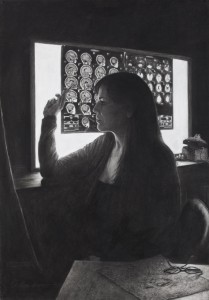 In 2009, Leslie suffered a mini-stroke. In Leslie’s words, “A medical scare always forces one to re-examine life, existence and purpose. It forces one to question personal philosophies.” The event of the stroke, followed by a period of introspection led to the creation of the self-portrait entitled “Sensazione: A Self-Portrait.” Leslie explains, “’A man paints with his brain and not with his hands.’ Reflecting upon this profound statement by Michelangelo following my stroke, I was forced to take pause and inspired to create a self-portrait. I was compelled to question – what is self? How does the brain relate to who we are, consciousness and the soul? What is the connection between the brain, hand and eye and our understanding of ourselves and our existence in the universe? As a visual artist, the fear of losing the function of thought, physical dexterity or sight was magnified. I addressed these issues in an image produced with the most basic of drawing materials: charcoal. I confronted my fears by creating this work with the inherent simplicity, elegance, power and beauty of black and white.”
In 2009, Leslie suffered a mini-stroke. In Leslie’s words, “A medical scare always forces one to re-examine life, existence and purpose. It forces one to question personal philosophies.” The event of the stroke, followed by a period of introspection led to the creation of the self-portrait entitled “Sensazione: A Self-Portrait.” Leslie explains, “’A man paints with his brain and not with his hands.’ Reflecting upon this profound statement by Michelangelo following my stroke, I was forced to take pause and inspired to create a self-portrait. I was compelled to question – what is self? How does the brain relate to who we are, consciousness and the soul? What is the connection between the brain, hand and eye and our understanding of ourselves and our existence in the universe? As a visual artist, the fear of losing the function of thought, physical dexterity or sight was magnified. I addressed these issues in an image produced with the most basic of drawing materials: charcoal. I confronted my fears by creating this work with the inherent simplicity, elegance, power and beauty of black and white.”
In her self-portrait, the artist can be seen in her world, at her easel. Her charcoal pencil in hand, studying what she is working on by the glow of light highlighting the very brain scans that inspired her to create this incredible piece. The drawing itself includes many symbolic images – the MRI scans, her eyeglasses, Leonardo Da Vinci’s Self-Portrait, and a handmade box embedded with cast fingertips created by her mentor Diana Attie, the first teacher, who in Leslie’s words “taught me to see.”
In 2011, Leslie Adams submitted “Sensazione: A Self-Portrait” to the “Toledo Area Artists 93rd Annual Exhibition” where it caught the attention of Dr. Brian Kennedy and Dr. Amy Gilman, the Toledo Museum of Art’s Director and Associate Director and Curator of Contemporary Art. The strength of the portrait won Leslie the first ever “Toledo Area Artists Solo Exhibition Award”. The award was a one person exhibition in Gallery 18 at the Toledo Museum of Art which was part of the museum’s Fall Season of Portraiture in 2012. This was a dream come true for Leslie.
In January, Leslie held a class for a group of University of Toledo art students in her gallery at the museum. Working with young artists is one of Leslie’s inspirations. About 50 students were there to hear about the exhibition and ask questions of what life is like as a working artist. Leslie discussed how this exhibition came to be. It was a fascinating to hear how an artist as talented as Leslie came up with a theme for the show and was intimidated by having to fill up an empty room in a museum with all original and new artwork.
Leslie told the students that she had the opportunity to meet Pulitzer Prize winning author Doris Kearns Goodwin during the sesquicentennial celebration at the Ohio Statehouse in 2011. Dr. Kearns-Goodwin reminded Leslie that the role of a portrait artist is not that much different than that of a biographer. She said that the role of both the artist and the biographer is to tell a story. Leslie asked herself, “Why not use this opportunity to tell my story?”
Leslie decided that she wanted the exhibition to be an inspiration to young artists and decided to tell her story, not on the pages of a book or in images on film, but in charcoal on paper and in oil on canvas. As she went around the room talking about each piece to the students, you could see the story of her life and of becoming an artist unfold in front of you.
She shared with the class that she first lived as a very young girl across the street from the Toledo Museum of Art. During this time, she spent hours roaming the halls, studying the masters and knowing from a very early age that she too wanted to become an artist. The Museum itself was a part of her childhood which became a significant character in her autobiography. Works like “The Cloister, Toledo Museum of Art” show Leslie as a young girl during Saturday art classes in the actual Cloister of the Toledo Museum of Art.
“This picture shows that I was rebellious even at an early age,” Leslie explained to the students. “You can see all of the children sitting in a circle drawing on the back of the t-shirt of the student in front of them, but not me.” In the portrait Leslie is seen off by herself, sketchbook on her lap, looking up from her drawing, concentrating on the column before her.
Other pieces from the exhibition also share her inspiration and share the importance of her mentor and teacher at TMA. “Attie’s Anatomy Academy” is a study of her anatomy classroom under the tutelage of Diane Attie. 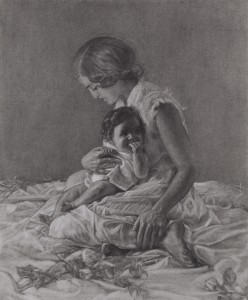 The viewer can see busts and skeletons posed in various positions around the room, easels with half-completed works, discarded drawings on the floor, a stack of books on a desk with “The Complete Works of Leonardo Da Vinci” on top of the stack. The room shown in this piece is from her time studying in the Department of Art of the University of Toledo at the Toledo Museum of Art.
The viewer can see busts and skeletons posed in various positions around the room, easels with half-completed works, discarded drawings on the floor, a stack of books on a desk with “The Complete Works of Leonardo Da Vinci” on top of the stack. The room shown in this piece is from her time studying in the Department of Art of the University of Toledo at the Toledo Museum of Art.
The works from the show “Leslie Adams: Drawn from Life” truly walk you through the life of this artist. Although they were not displayed chronologically, each drawing and painting gave a snap shot of a time in her life and how she grew to become the artist she is today. It begins with a portrait of Leslie being held as a baby by her mother called “Madonna and Child with Roses,” one of the smallest portraits in the exhibition. This charcoal drawing was a touching piece showing the bond between mother and child. Also included was “Portrait of the Artist’s Father,” a handsome head and shoulders portrait of her dad with a half grin and glint in his eye. These two portraits will not be sold and are staying in her private collection.
The timeline of her life continued with a portrait of Leslie as a young girl drawing on napkins in “The Purity of Imagination and Color” a nod, stylistically, to Édouard Manet’s “ABar at the Folies – Bergère.” Leslie explained to the class that some of her early childhood memories were of sitting in the restaurant that close family friends owned. With crayons in hand, a Shirley Temple at her side and napkins and paper upon which to draw, Leslie copied each image as though it was an Old Master reproduction. This picture was unique in the exhibition, as it was the only painting and only portrait in vibrant color. Leslie discussed the specifics of the napkin designs that she duplicated, the 1970’s coke bottle, the dress that she originally wore as a child, and the crayon box that was of the correct period. She even shared that this was the first box of 64 to include the fancy, new “built-in” sharpener.
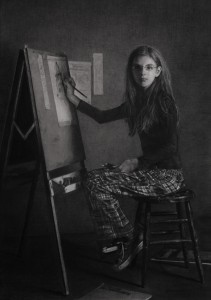 The image that was used on the cover of the TMA catalog about the exhibition was of Leslie as a young adolescent called “Portrait of the Artist as a Young Girl.” As Leslie talked to the students about this drawing, she discussed her efforts to find a young girl who resembled her at this particular age, a “mini-me” or a doppelganger, to sit for the portrait. She even shared a humorous story with the class of how awkwardly she felt when crashing “Girl Scout Night” at the museum looking for the right young girl to portray her. With the help of a friend on faculty at the Toledo School for the Arts, she ultimately found a precocious eighth grader, Reagan Shull, who enthusiastically modeled for several of the works in the exhibition. This image is striking as it features Leslie as a young girl with a look a fierce determination, messy hair, glasses, plaid slacks, and the traditional, ubiquitous Keds. It appears that the viewer distracted the young, working artist. With pencil in hand, still touching the paper; she looks up from her sketch. In this work, the young artist is sketching Winky from the “Draw Me” ads that promoted the chance to win a drawing school scholarship.
The image that was used on the cover of the TMA catalog about the exhibition was of Leslie as a young adolescent called “Portrait of the Artist as a Young Girl.” As Leslie talked to the students about this drawing, she discussed her efforts to find a young girl who resembled her at this particular age, a “mini-me” or a doppelganger, to sit for the portrait. She even shared a humorous story with the class of how awkwardly she felt when crashing “Girl Scout Night” at the museum looking for the right young girl to portray her. With the help of a friend on faculty at the Toledo School for the Arts, she ultimately found a precocious eighth grader, Reagan Shull, who enthusiastically modeled for several of the works in the exhibition. This image is striking as it features Leslie as a young girl with a look a fierce determination, messy hair, glasses, plaid slacks, and the traditional, ubiquitous Keds. It appears that the viewer distracted the young, working artist. With pencil in hand, still touching the paper; she looks up from her sketch. In this work, the young artist is sketching Winky from the “Draw Me” ads that promoted the chance to win a drawing school scholarship.
Another work in “Drawn from Life” represents Leslie’s time when she moved to New York City to attend the New York Academy of Art on full scholarship following her graduation from The University of Toledo. Leslie shared with the class her fear of moving to the big city alone. An exceptionally touching picture from this period was “Portrait of a Young American Artist.” This triptych portrays Leslie at the Metropolitan Museum of Art in the middle of the night. Leslie is seen sitting, leaning against one of its majestic columns, dreaming, and staring at a banner in front of the museum that reads “Portraits by American Artists in the Metropolitan Museum of Art” a major exhibition at the museum in 1992. It is still Leslie’s dream to have her work included in the Met’s permanent collection.
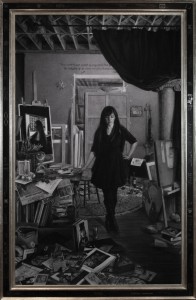 Leslie shared with the UT students the stories behind each of the portraits ending with the centerpiece of the exhibit “The Art of Life.” This incredible self-portrait is a true study of the artist today and what led her to this place. Other works from the show only shared a snapshot in time. “The Art of Life” shares the true full story. Leslie is standing in the center of the painting looking down at the floor in her studio. She is surrounded by items significant to her career and life: artist’s monographs, books on painting and drawing technique, museum catalogs, magazines and newspaper clippings, paintbrushes. Every item in this picture has a very special meaning to her. The “bookends” in the drawing are copies of her parent’s marriage certificate (on the floor in the front left corner) and a copy of the announcement of the “Leslie Adams: Drawn from Life” exhibition (in the right corner). These two important dates in her life were coincidentally and exactly 55 years apart to the day. On an easel in the background is “Sensazione: A Self Portrait,” the picture that she submitted to win the solo exhibit at TMA. A bowl on the floor is a ceramic piece done by close friend, the late Edith Franklin, Toledo’s “Queen of Pots.” A Toledo Mud Hens baseball is on the floor referencing her studio location, always across the street from the stadium. A Toledo Blade article announcing a prize from a poster contest she entered as a child lies haphazardly across the floor. A Diet Coke can is on the floor at her feet. From what at first appears to be random items strewn everywhere in the picture is actually a carefully woven story of the artist’s life in this monumental drawing.
Leslie shared with the UT students the stories behind each of the portraits ending with the centerpiece of the exhibit “The Art of Life.” This incredible self-portrait is a true study of the artist today and what led her to this place. Other works from the show only shared a snapshot in time. “The Art of Life” shares the true full story. Leslie is standing in the center of the painting looking down at the floor in her studio. She is surrounded by items significant to her career and life: artist’s monographs, books on painting and drawing technique, museum catalogs, magazines and newspaper clippings, paintbrushes. Every item in this picture has a very special meaning to her. The “bookends” in the drawing are copies of her parent’s marriage certificate (on the floor in the front left corner) and a copy of the announcement of the “Leslie Adams: Drawn from Life” exhibition (in the right corner). These two important dates in her life were coincidentally and exactly 55 years apart to the day. On an easel in the background is “Sensazione: A Self Portrait,” the picture that she submitted to win the solo exhibit at TMA. A bowl on the floor is a ceramic piece done by close friend, the late Edith Franklin, Toledo’s “Queen of Pots.” A Toledo Mud Hens baseball is on the floor referencing her studio location, always across the street from the stadium. A Toledo Blade article announcing a prize from a poster contest she entered as a child lies haphazardly across the floor. A Diet Coke can is on the floor at her feet. From what at first appears to be random items strewn everywhere in the picture is actually a carefully woven story of the artist’s life in this monumental drawing.
When asked how she would label herself: portrait artist, figurative artist, or, simply, artist, she said she was moved by the words of Everett Raymond Kinstler, a very prominent portrait artist who lectures annually at the Portrait Society of America’s “Art of the Portrait” conference that she always attends. He shared the following advice with fellow artists saying, “Don’t be a portrait artist, be an artist, be an artist first. Paint landscapes. Paint still life. Go out and do watercolors because watercolors will inform oil paintings. Just do everything.” Leslie was inspired by Kinstler’s words and shared that she does find herself concentrating strictly on portraits and wishes to find the time to do precisely what Kinstler advises. One of the many great things about doing her solo show was that it gave her the opportunity to broaden the scope of her subject matter. Leslie was given free rein to create what she wanted by Dr. Kennedy and Dr. Gilman of TMA. She was told to do what she has always wanted to do but didn’t have the time or the means. She was told to have fun! “I learned so much during in the process of preparing the exhibition, I did many things right and I did many things wrong when I was preparing for the show. But to answer the original question, do I call myself a portrait artist? Yes! But to add a disclaimer, on the back of my brand new business cards I did put Figurative Art and Portraiture. Now, that I have had the time to produce this solo exhibition I have an entirely new body of work that is beyond simply portraiture,” said Leslie.
So what is the future for this talented artist Leslie Adams? Several exciting developments have occurred since her show at the Toledo Museum of Art. Leslie submitted “Sensazione: A Self-Portrait” into The Smithsonian Institution, National Portrait Gallery’s Outwin Boochever Portrait Competition. This is a triennial event that invites figurative artists to submit entries in all media to be considered for display at the Smithsonian National Portrait Gallery. The endowment from the late Virginia Outwin Boochever has enabled the museum to conduct this national portrait competition and exhibition which encourages artists to explore the art of portraiture.
From more than 3,000 entries from every state, a jury of experts chose 48 works of art in a variety of media, including painting, sculpture, drawing, textile, photography, video and mixed media. Leslie Adams’ “Sensazione: A Self-Portrait” was one of the winning 48 portraits and will now be on display at the Smithsonian through February 23, 2014.
“Last summer in the midst of all of the preparations for the Toledo Museum of Art show, the Smithsonian sent art handlers to my studio to pick up my self-portrait and take it away,” Leslie shared. All 100 portraits were brought to Washington and they displayed them in a warehouse. Competition judges then judged the works and narrowed them down to the top 48 portraits. Leslie found out that her portrait was included in the top 48 about a week before her show opened at the Toledo Museum of Art. Leslie said, “The funny thing is that the TMA’s director and associate director, really wanted to have that portrait in my show because that was the portrait that I submitted that won the award for the exhibition in the first place. Instead, you can see “Sensazione” on the easel in the “Art of Life” because now it is displayed in The Smithsonian Institution. To learn about the Outwin Boochever Portrait Competition or to see Leslie’s work and the other 47 winners, click here to visit the competition website. You can also vote for The People’s Choice award.
Other exciting news for Leslie Adams is that she was invited to exhibit “Portrait of the Artist as a Young Girl” in Atlanta in April. It is one of 20 pieces that The Portrait Society of America chose for their “International Portrait Competition” at the “Art of the Portrait” annual conference. The “International Portrait Competition” is open to all artists. The top 20 finalists are required to exhibit their selected original artwork and be present at the prestigious “Art of the Portrait” conference in Atlanta, GA. The goal of this competition is to create an exhibition, in conjunction with their annual conference, of the finest portrait and figurative work being created today worldwide. Leslie describes, “The Portrait Society of America is a wonderful organization. This is their 15th anniversary and every year they hold this competition. Only the top 20 get to take their artwork to the conference and there are probably about 850 portrait artists from all over the world that attend. I’ve only attained the chance to take my artwork there one other time, so I am really excited that “Portrait of the Artist as a Young Girl” was selected for this year’s competition.”
And the results are in! Leslie’s portrait won the highest honor at the competition. “Portrait of the Artist as a Young Girl” was selected to receive The “William F. Draper Grand Prize.” The prize includes a major cash award as well as a feature article in “International Artist Magazine,” “American Art Collector Magazine,” and recognition in the “Art of the Portrait Journal.” Leslie is only the second woman to win this international award and the first artist to win the competition with a drawing. If you would like to see Leslie’s portrait and the others that were in the competition, visit their website.
So where does she go from here? Leslie states, “There was a great benefit to my solo show being held during “Manet: Portraying Life” and during the holidays at the museum. There were so many visitors from around the world who came back to spend time with their families at the museum. I am still overwhelmed by the positive response to my exhibition. There was a letter, in fact, sent to the museum from a gentleman who lives in Washington, D.C., that greatly inspired me. He wrote about his visit to see his parents and to see my show. In his letter he talked about the memories my exhibition conjured up for him. The letter was inspiring for me because he talked about things that I had forgotten. He remembered things that happened back in the 60’s, 70’s and 80’s. Things we were allowed to do in the museum that we are not allowed to do anymore. So, in part because of that letter, I want to create new works that are inspired by his ideas.
“I also want the exhibition to travel to other museums. Ideally, I would love to take it to those institutions with which I already maintain a relationship. I want to add a personal twist to each show, like the Butler Institute of American Art, for example. I have a piece specifically in mind for that museum. So, the show will not be exactly the same as it was at the Toledo Museum of Art. There were also many other ideas I had for paintings for this exhibit that I want to develop. Some people were a little disappointed that there were so many drawings instead of paintings. There were ideas I had for paintings, but I had less than a year and didn’t have the time to do this show in oil. I want to follow through with those ideas and already have the canvasses stretched.”
Meanwhile, as Leslie continues to focus on her new work, she continues her work as a commissioned portrait artist for which she has primarily devoted her career. She is currently working on several other official portraits for the Supreme Court of Ohio, the Ohio Senate and House of Representatives and the Ohio Statehouse as well as portraits for the Ohio State University and several private individuals and institutions throughout the United States. Perhaps, someday soon we will also see a presidential portrait by Leslie Adams in the White House, as this, too, is one of her dreams.
It is easy to see why these past two years have been busiest in Leslie Adams’ career, but as she said, “I am not complaining! I may get tired but I never complain about the work because I am really, really fortunate. As an artist living in Toledo, Ohio, I often find myself defending this choice…people think that you have to live in New York or LA or Chicago but I don’t believe that’s true. I originally returned to Toledo because of my family but I have no family left here anymore. The things that are keeping me here are my very good friends, the support of my community, the University of Toledo and the Toledo Museum of Art…all that I love and adore. I could leave but I love so much about Toledo, my studio and my home.”
To learn more about Leslie Adams or to see more of her artwork, visit her website at www.leslieadams.com






